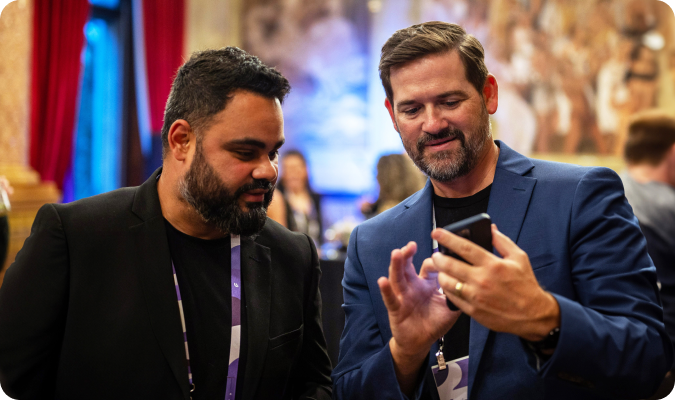
The way we approach accessible event design is changing, and it’s changing for the better.
Accessibility is no longer a “nice to have” or a box to tick at the bottom of your run sheet. It’s a core expectation driven by new global regulations, a more digitally engaged audience, and a growing demand for inclusivity at every touchpoint.
Whether you’re managing large-scale conferences, high-volume rollouts, or complex hybrid formats, accessible event design is a strategic advantage and a legal responsibility.
In this EventsAir article, we discuss the importance of accessible event design, elements of accessibility that you need to consider in 2025, and how we’re ensuring our technology is consistently evolving with accessibility requirements.
Why accessibility matters more than ever
The World Health Organization estimates that over 1.3 billion people live with some form of disability. That’s 1 in 6 people worldwide, and a significant portion of your potential audience.
Accessibility isn’t just about ramps and restroom signage. In 2025, it’s about ensuring every attendee – onsite or online – can fully participate in your event experience. Accessible design also means your event content is easier to navigate, engage with, and share; by all attendees, not just those with specific needs.
Here’s why accessibility is rising to the top of every event planner’s priority list:
- The European Accessibility Act (EAA) is coming into force, requiring digital platforms, ticketing services, and e-commerce interfaces to meet specific accessibility standards by mid-2025.
- Virtual and hybrid events have reshaped expectations. Captions, keyboard navigation, high-contrast visuals, and screen-reader-friendly content are now baseline, not bonus.
- Audience diversity is increasing. That includes mobility needs, neurodiversity, visual and auditory impairments, and language barriers.
- Brand reputation and legal compliance are linked. Accessible design reduces risk and improves trust.
What accessible event design looks like in 2025
Let’s break it down. Accessible event design means rethinking every touchpoint through the lens of equity and usability; it’s a layered approach that touches every part of your planning process. From the way someone registers to how they experience a keynote in real time, accessibility means designing for all attendees.

Here’s how accessibility shows up across the event journey in 2025:
1. Accessible registration and communications
The event journey begins well before the welcome address. Registration is your first impression, and it should be accessible too.
- Accessible forms and fields: Ensure registration forms can be navigated via keyboard and screen readers. Fields should have proper labels, and error messages must be clear and helpful.
- Multiple formats and contact options: Offer alternatives to online registration, such as phone support or downloadable PDFs.
- Inclusive language: Use clear, jargon-free language. Avoid idioms, slang, or overly technical terms unless you define them.
- Text alternatives for visual content: Every image, button, or infographic needs meaningful alt text that screen readers can interpret.
- Consistent structure: Keep headers, buttons, and navigation consistent throughout your site or app to support users with cognitive or visual impairments.
2. Designing the onsite experience with equity in mind
Physical environments still matter, even in a hybrid world. Accessibility must be baked into venue selection, staff training, and onsite logistics.
- Mobility access: Ensure venues have wide doorways, ramps, elevators, and accessible bathrooms. Layouts should support unobstructed movement for wheelchairs, walkers, or service animals.
- Clear, high-contrast signage: Wayfinding signage should use large fonts, high-contrast colors, and non-glare finishes to help low-vision attendees navigate confidently.
- Sensory-friendly spaces: Offer quiet rooms or low-stimulation zones for neurodivergent attendees or those managing fatigue.
- Flexible seating and priority access: Designate priority seating close to exits or screens and ensure front-row access for interpreters or attendees with hearing needs.
- Staff and volunteer training: Equip your team with the knowledge to assist respectfully. A short training on disability etiquette can make a huge difference.
3. Virtual and hybrid participation that’s truly inclusive
Digital access isn’t a fallback anymore, it’s a key part of your attendee journey.
- Live captioning and sign language interpretation: These are must-haves for keynotes, panels, and Q&A sessions. Don’t rely solely on automated captions, invest in accuracy.
- Multiple content formats: Make sessions available as transcripts, audio-only files, or video with captions after the event. It’s not just about access, this covers varying learning styles too.
- Platform compatibility: Ensure your virtual platform works with assistive technologies like screen readers, speech-to-text, or alternative input devices.
- Flexible viewing options: Let attendees control font sizes, playback speed, and background colors. Simple UI preferences go a long way for neurodiverse audiences.
- Inclusive interaction tools: Chat boxes, polls, and Q&A functions should be operable with a keyboard and readable by screen readers. Avoid flashy or auto-playing elements that distract or disorient.
Getting started: How to future-proof your events
You don’t need to overhaul everything overnight, but you do need a plan. Here’s where to start:
- Audit your digital assets – Registration pages, event websites, and virtual platforms.
- Involve your audience – Ask attendees for access needs during registration.
- Use accessible templates – For agendas, communications, and feedback forms.
- Train your team – On inclusive language, interface testing, and onsite support.
- Choose tech that’s built for accessibility – Your event management platform should help you meet compliance standards, not hinder them.
EventsAir’s commitment to accessible event experiences
At EventsAir, accessibility isn’t an afterthought, it’s a core part of how we design, build, and evolve our platform.
We’re committed to creating a digital environment where everyone can engage fully, no matter their device, ability, or access needs. That means delivering an attendee experience that’s inclusive, user-friendly, and in step with the latest global accessibility standards.
Where we stand today
At EventsAir, we recognize that achieving full accessibility is an ongoing journey. We’re committed to continuous improvement as we work towards a more inclusive experience for all event attendees.
As of April 2025, our platform is already partially compliant with the European Accessibility Act (EAA) and the Web Content Accessibility Guidelines (WCAG) 2.1 Level AA – and we’re actively progressing toward full compliance.
Many areas of our attendee experience already align with these standards, but we know there’s still work to do.
How we’re raising the bar
We’ve laid out a clear roadmap to reach and exceed compliance:
- Targeted remediation efforts are underway, focused on improving keyboard navigation, screen reader compatibility, and other key user interface elements.
- Development and QA enhancements are being embedded into our day-to-day workflows, ensuring accessibility is considered at every stage of the product lifecycle.
- A third-party accessibility audit is in progress to validate compliance, document any gaps, and certify our platform’s accessibility performance.
- We’ve committed to ongoing, regular testing, combining automated tools and manual evaluations to proactively identify and resolve issues.

Accessibility isn’t a feature, it’s a standard
In 2025 and beyond, accessible event design is not just a trend, it’s how standout events are built. It makes your experiences stronger, your audience broader, and your outcomes better. Whether you’re navigating new compliance standards or reimagining your attendee journey, the goal is simple: everyone deserves to belong.
Want to see how EventsAir makes inclusive event delivery simple? Book a demo today and explore the accessibility features built to support your goals.
Attendee Experience | Event Planning & Management
See EventsAir in action
Discover why 12,000+ event professionals trust EventsAir to deliver effortless events, every time.




